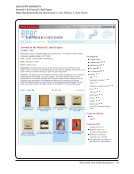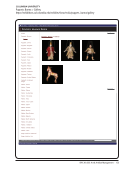48 · Survey Results: Survey Questions and Responses
Challenge 1 Challenge 2 Challenge 3
Making PastPerfect database available
for public use.
Rehousing for physically fragile objects. Need for conservation work on fragile
sculptures.
Need for recognition! Without adequate
documentation, it is difficult to convey to
the library, the campus and the world in
general the importance of this collection
for research, teaching and learning.
Many patrons find us by accident,
random searching on the net, by word
of mouth, or through the publications
of others. Also, the unrecognized but
high monetary value of some of the
items is an in-house issue for security,
appropriate housing and storage, and
proper inventorying /appraisal.
Need to post “it” on the web! The size
and diversity of the collection makes it
impossible for one person to manage to
the level we have come to expect in this
era, or to have the necessary expertise in
all the areas required. Piecemeal patron
demand for digital images and metadata
creates a just-in- time, on-the-fly
mentality that runs ahead of coordinated
collection-wide decisions on standards
for management, identification,
numbering, proper description, and
handling of images. There is a pervasive
expectation that the whole(?) collection
will be posted on the library website. Our
current website has been dead for years.
I have not faced revising it without some
better foundation in place for presenting
the collection. No other collections in the
Library have these problems on this scale,
so there not much willingness to initiate
serious discussions.
Need for support! The expectation is
that we should “go for a grant” to do
all we need. This is an obvious solution,
but would probably involve several large
grants over a period of time. Before we
can ask for such support and manage
any kind of grant, (1) we need to count
or specify how many items are involved,
(2) the library needs to make decisions
on collection management and standards
and guidelines for digitizing collection
in general, so we can describe what we
propose to do, and (3) support for a big
web re-design in available.
Our institution had some art/artifact
pieces that were not fully documented
when they arrived and current staff
have created an artificial “art/artifact”
collection to track and inventory these
pieces. The information about these
pieces is fragmentary. Currently, as pieces
arrive they are accessioned as part of
the collections they arrive with and their
records are more robust.
Rehousing is on the item level, and we
wish we had better framed art, artifact,
art storage.
Presenting art collection information to
researchers.
Physical housing and care, including
conservation, restoration.
Some categories are low priority.
Description and access are labor
intensive.
Research value is not always apparent.
Treatment such as digitization and
creation of metadata can increase the
usefulness and research value of the
materials, but such treatment is costly
and is not obviously justifiable to funding
agencies.
Physical storage. Accessibility along with related material
in more traditional/accessible formats.
Usefulness of finding aids and descriptive
language.
Challenge 1 Challenge 2 Challenge 3
Making PastPerfect database available
for public use.
Rehousing for physically fragile objects. Need for conservation work on fragile
sculptures.
Need for recognition! Without adequate
documentation, it is difficult to convey to
the library, the campus and the world in
general the importance of this collection
for research, teaching and learning.
Many patrons find us by accident,
random searching on the net, by word
of mouth, or through the publications
of others. Also, the unrecognized but
high monetary value of some of the
items is an in-house issue for security,
appropriate housing and storage, and
proper inventorying /appraisal.
Need to post “it” on the web! The size
and diversity of the collection makes it
impossible for one person to manage to
the level we have come to expect in this
era, or to have the necessary expertise in
all the areas required. Piecemeal patron
demand for digital images and metadata
creates a just-in- time, on-the-fly
mentality that runs ahead of coordinated
collection-wide decisions on standards
for management, identification,
numbering, proper description, and
handling of images. There is a pervasive
expectation that the whole(?) collection
will be posted on the library website. Our
current website has been dead for years.
I have not faced revising it without some
better foundation in place for presenting
the collection. No other collections in the
Library have these problems on this scale,
so there not much willingness to initiate
serious discussions.
Need for support! The expectation is
that we should “go for a grant” to do
all we need. This is an obvious solution,
but would probably involve several large
grants over a period of time. Before we
can ask for such support and manage
any kind of grant, (1) we need to count
or specify how many items are involved,
(2) the library needs to make decisions
on collection management and standards
and guidelines for digitizing collection
in general, so we can describe what we
propose to do, and (3) support for a big
web re-design in available.
Our institution had some art/artifact
pieces that were not fully documented
when they arrived and current staff
have created an artificial “art/artifact”
collection to track and inventory these
pieces. The information about these
pieces is fragmentary. Currently, as pieces
arrive they are accessioned as part of
the collections they arrive with and their
records are more robust.
Rehousing is on the item level, and we
wish we had better framed art, artifact,
art storage.
Presenting art collection information to
researchers.
Physical housing and care, including
conservation, restoration.
Some categories are low priority.
Description and access are labor
intensive.
Research value is not always apparent.
Treatment such as digitization and
creation of metadata can increase the
usefulness and research value of the
materials, but such treatment is costly
and is not obviously justifiable to funding
agencies.
Physical storage. Accessibility along with related material
in more traditional/accessible formats.
Usefulness of finding aids and descriptive
language.


















































































































































































